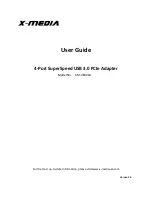
PEAP
Protected Extensible Authentication Protocol (PEAP) is an Internet
Engineering Task Force (IETF) draft protocol sponsored by
Microsoft, Cisco, and RSA Security. PEAP creates an encrypted
tunnel similar to the tunnel used in secure web pages (SSL). Inside
the encrypted tunnel, a number of other EAP authentication
methods can be used to perform client authentication. PEAP
requires a TLS certificate on the RADIUS server, but unlike EAP-
TLS there is no requirement to have a certificate on the client.
PEAP has not been ratified by the IETF. The IETF is currently
comparing PEAP and TTLS (Tunneled TLS) to determine an
authentication standard for 802.1X authentication in 802.11
wireless systems. PEAP is an authentication type designed to take
advantage of server-side EAP-Transport Layer Security (EAP-TLS)
and to support various authentication methods, including user's
passwords and one-time passwords, and Generic Token Cards.
Peer-to-Peer
Mode
A wireless network structure that allows wireless clients to
communicate with each other without using an access point.
Power Save
mode
The state in which the radio is periodically powered down to
conserve power. When the notebook is in Power Save mode,
receive packets are stored in the access point until the wireless
adapter wakes up.
Preferred
network
One of the networks that has been configured. Such networks are
listed under Preferred networks on the Wireless Networks tab of
the Wireless Configuration Utility (Windows 2000 environment) or
Wireless Network Connection Properties (Windows XP
environment).
RADIUS
Remote Authentication Dial-In User Service (RADIUS) is an
authentication and accounting system that verifies user's
credentials and grants access to requested resources.
RF
Radio Frequency. The international unit for measuring frequency is
Hertz (Hz), which is equivalent to the older unit of cycles per
second. One Mega-Hertz (MHz) is one million Hertz. One Giga-
Hertz (GHz) is one billion Hertz. For reference: the standard US
electrical power frequency is 60 Hz, the AM broadcast radio
frequency band is 0.55 -1.6 MHz, the FM broadcast radio frequency
band is 88-108 MHz, and microwave ovens typically operate at
2.45 GHz.
Roaming
Movement of a wireless node between two micro cells. Roaming
usually occurs in infrastructure networks built around multiple
access points. Current wireless network roaming is only supported
in the same subnet of a network.
RTS threshold The number of frames in the data packet at or above which an RTS/
CTS (request to send/clear to send) handshake is turned on before
the packet is sent. The default value is 2347.
Shared Key
An encryption key known only to the receiver and sender of data.
Summary of Contents for Wireless WiFi Link 4965AGN
Page 31: ...Back to Top Back to Contents Trademarks and Disclaimers ...
Page 36: ...Back to Top Back to Contents Trademarks and Disclaimers ...
Page 144: ...Back to Contents Trademarks and Disclaimers ...
Page 152: ...Back to Top Back to Contents Trademarks and Disclaimers ...
Page 174: ......
Page 175: ......
Page 183: ......
















































